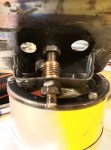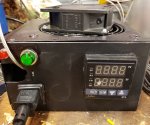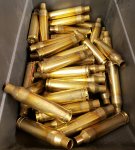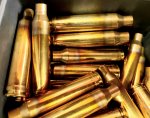Intro & background:
I completed my build and salt bath annealing system and I want to share it for those of you who are interested in it. I did an enormous amount of research before I decided on this method and my goal was to have a dummy-proof set-up where I could spend the least amount of time possible annealing my brass.
I use to Cast Boolits so I am familiar with PID Controllers and Lee pots.
I have a couple of videos I took illustrating my set-up and annealing virgin Norma 7mm RM brass. I'll include a list of items I used to build the PID Temperature controller, the Lee pot, and the low temperature salts. With the proper safeties in place, this can be a economical way to anneal brass. For me, the proof is in the pudding. I used Tempilaq 750* on my 20 or so pieces of test brass before going for it and I annealed 100 BRAND NEW virgin pieces of Norma brass @ 1.25 each!
And a note, it is 32* outside today and the PID has no problem maintaining the temperature.
Lee Precision Reloading Precision Lead Melting Pot 90021- https://www.ebay.com/itm/Lee-Precision-Reloading-Precision-Lead-Melting-Pot-90021/233058679208?ssPageName=STRK:MEBIDX:IT&_trksid=p2057872.m2749.l2649
Top plate and shell holder- I used some 1/8" steel plate that I had in a scrap pile, the bottom part of the plate that is in direct contact with the salt solution is bare metal. For the shell holder, I used some scrap pieces of brass that I had from a plumbing project. YOU DO NOT WANT TO USE ALUMINUM, the salts will eat it.
PID Build-
https://www.auberins.com/index.php?main_page=product_info&cPath=1&products_id=3
https://www.auberins.com/index.php?main_page=product_info&cPath=2_30&products_id=9
https://www.auberins.com/index.php?main_page=product_info&cPath=7_33&products_id=606
Ball Bearing PC Computer Case Cooling Fan120x120x25mm AC 115V Metal link depot
https://www.auberins.com/index.php?main_page=product_info&cPath=61_63&products_id=274
High Performance Silver Thermal Grease CPU Heatsink Compound Paste Syringe
Heatsink heat sink for a 25A SSR Solid State Relay
Temp Thermocouple K type, stainless Steel Probe, 2m (6.5ft), teflon sealed
https://www.ebay.com/itm/AC-Distrib...=item26102a2f45:g:UikAAOSwBPRcDzH2:rk:42:pf:0
I used a 500w computer power supply (stripped) that already had a male power socket and a power switch. If you use a different enclosure, you will need a power switch and male power socket. I used 14-18 gauge wire to wire everything and I also used wire connectors that I had already. At a later time, I can include a wiring schematic but I'll have to create that because I modified my last PID build. I have the 100V fan wired directly to the Solid State Relay (SSR) so that the fan only comes on when the SSR is running. It is not hard to build the PID...even a caveman can do it!
Salts-
Low Temperature Salts for Heat Treating Quick Temper 275 by Hubbard-Hall
I ordered 3 lbs due to the high shipping charges http://www.hightemptools.com/salts.html
Metronome- I downloaded a basic metronome to my phone so I can be precise on inserting and taking out the brass. I set it to 50 beats per minute and my brass calls for 8 seconds @ 943* F. YMMV...
I think that is everything...
VIDEOS:
Pictures:





I completed my build and salt bath annealing system and I want to share it for those of you who are interested in it. I did an enormous amount of research before I decided on this method and my goal was to have a dummy-proof set-up where I could spend the least amount of time possible annealing my brass.
I use to Cast Boolits so I am familiar with PID Controllers and Lee pots.
I have a couple of videos I took illustrating my set-up and annealing virgin Norma 7mm RM brass. I'll include a list of items I used to build the PID Temperature controller, the Lee pot, and the low temperature salts. With the proper safeties in place, this can be a economical way to anneal brass. For me, the proof is in the pudding. I used Tempilaq 750* on my 20 or so pieces of test brass before going for it and I annealed 100 BRAND NEW virgin pieces of Norma brass @ 1.25 each!
And a note, it is 32* outside today and the PID has no problem maintaining the temperature.
Lee Precision Reloading Precision Lead Melting Pot 90021- https://www.ebay.com/itm/Lee-Precision-Reloading-Precision-Lead-Melting-Pot-90021/233058679208?ssPageName=STRK:MEBIDX:IT&_trksid=p2057872.m2749.l2649
Top plate and shell holder- I used some 1/8" steel plate that I had in a scrap pile, the bottom part of the plate that is in direct contact with the salt solution is bare metal. For the shell holder, I used some scrap pieces of brass that I had from a plumbing project. YOU DO NOT WANT TO USE ALUMINUM, the salts will eat it.
PID Build-
https://www.auberins.com/index.php?main_page=product_info&cPath=1&products_id=3
https://www.auberins.com/index.php?main_page=product_info&cPath=2_30&products_id=9
https://www.auberins.com/index.php?main_page=product_info&cPath=7_33&products_id=606
Ball Bearing PC Computer Case Cooling Fan120x120x25mm AC 115V Metal link depot
https://www.auberins.com/index.php?main_page=product_info&cPath=61_63&products_id=274
High Performance Silver Thermal Grease CPU Heatsink Compound Paste Syringe
Heatsink heat sink for a 25A SSR Solid State Relay
Temp Thermocouple K type, stainless Steel Probe, 2m (6.5ft), teflon sealed
https://www.ebay.com/itm/AC-Distrib...=item26102a2f45:g:UikAAOSwBPRcDzH2:rk:42:pf:0
I used a 500w computer power supply (stripped) that already had a male power socket and a power switch. If you use a different enclosure, you will need a power switch and male power socket. I used 14-18 gauge wire to wire everything and I also used wire connectors that I had already. At a later time, I can include a wiring schematic but I'll have to create that because I modified my last PID build. I have the 100V fan wired directly to the Solid State Relay (SSR) so that the fan only comes on when the SSR is running. It is not hard to build the PID...even a caveman can do it!
Salts-
Low Temperature Salts for Heat Treating Quick Temper 275 by Hubbard-Hall
I ordered 3 lbs due to the high shipping charges http://www.hightemptools.com/salts.html
Metronome- I downloaded a basic metronome to my phone so I can be precise on inserting and taking out the brass. I set it to 50 beats per minute and my brass calls for 8 seconds @ 943* F. YMMV...
I think that is everything...
VIDEOS:
Pictures:





Last edited:

